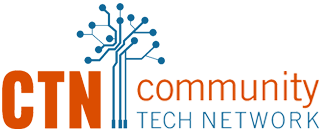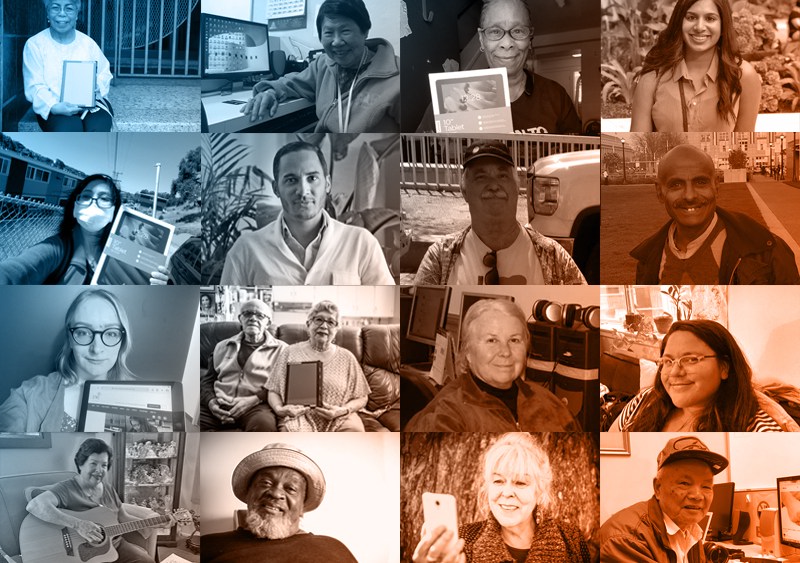Photo: Some of 2020’s Home Connect older adult learners, volunteer digital coaches, and supporting CTN staff members.
We are used to sharing heartwarming, inspirational stories in this space. In 2020, we all managed significant impacts due to the pandemic. We also shared common experiences in adjusting to our new environments and lifestyles — each in our own way. Every aspect of our lives was affected: at home and at work, in school or at play. Though the road was not always smooth, we are proud of how Community Tech Network survived and even thrived throughout this most difficult year.
The year began with our usual optimism and expectations. January and February were business-as-usual as we continued to fulfill obligations and agreements with our training partners and funders. We continued program development and expansion while enhancing our ongoing training platforms. We pursued new training strategic partners and sought to expand the number of our training locations.
The Pandemic’s First Impact
In early March, we sensed that major changes were in the air, but none of us expected the stay-at-home mandates and the loss of our “bread and butter” programming — access to our clients at community centers, libraries, senior centers, and other venues where we met with our learners face-to-face. Our traditional business model simply ceased — literally overnight.
The sudden isolation of our most vulnerable clients — older adults living alone with no home internet or digital device to access it — became our inspiration and motivation. They were the group most impacted, the most vulnerable to COVID-19, and the most at risk from a safety, health, and emotional perspective. Improving their situation became our focus and greatest challenge.
The Vision
Kami Griffiths, CTN’s executive director and co-founder, has spent the 12 years since our creation dreaming of what CTN could and should become: how we grow and expand to reach more people in need and how we work with them in new ways. One of the concepts she worked on from the early days became our unifying organizational focus and is now known as Home Connect. She had a vision to reach older adults unable to access programming in community settings by leveraging technology (after all, it’s what we do) to reach them virtually at home.
In late March, Kami gathered her key staff (remotely, of course) to begin working through the many challenges and opportunities we faced in developing and implementing this radical programming shift.
The Challenges
Three critical key elements were quickly identified as the focus of CTN’s planning efforts:
- The number of older adults that could be reached would dramatically decrease since virtual training would shift to one-on-one rather than small group settings. A robust volunteer recruitment program would need to be initiated, creating the capacity to train more seniors at the same time.
- Because we would be able to reach fewer seniors at one time, we needed to identify and prioritize the most vulnerable. This required the collaboration and cooperation of our traditional partners in helping us identify and recruit the learners in greatest need.
- In our traditional programming model, learners used devices accessible at the various locations in a computer-lab-type setting. In most cases, these devices were the property of the partner agency and were not kept by the learner. CTN needed to identify new funding sources that would provide a device for each learner that they could retain at the end of training. In addition to devices, we needed a strategy to secure home internet access for those isolated older adults who did not have it.
The Story Continues …
So that is how it all started. In a very short period of time, the wheels were put in motion. Incredible as it may seem, CTN’s first Home Connect learner, Vivian Irving, began her remote training on April 27. Twelve years of vision, commitment, and dedication to those we serve allowed CTN to dramatically change direction in a little more than 30 days!
Home Connect has embarked on a process of continual improvement, the evolution of remote learning, and program expansion based on the lessons learned from our initial participants. As staff and volunteer trainers became more comfortable and effective working with learners in a remote setting, the curriculum was revised, and the training grew to touch more seniors (including instruction now available in seven languages).
As the summer progressed, senior staff collaborated with our training partners to transition pre-COVID in-person training agreements to remote Home Connect–style formats. This resulted in CTN fulfilling several contractual obligations by delivering virtual instruction in a group format to learners remaining safe in their homes. Modifications have also transformed our train-the-trainer program, which empowers training partners to utilize their staff and volunteers to deliver our Home Connect curriculum to their members and clients.
Home Connect’s successes as well as our other work have been well documented through the almost 100 blog posts on our website published throughout 2020. These posts focus on a variety of activities and include student learner spotlights and stories about our committed professional staff, our enthusiastic and dedicated volunteers, and our training and funding partners.
We Couldn’t Have Done It Without You!
As the year draws to a close, we take great pride in Home Connect’s accomplishments. None of this would have been possible without the remarkable support of San Francisco’s Department of Disability and Aging Services. They allowed CTN to use SF Connected funding to get the Home Connect program off the ground. Two other funders, Metta Fund and Newhall Foundation, allowed us to shift funding to support Home Connect, while AT&T provided a generous grant allowing us to purchase the first 100 tablets. Dozens of individuals have made financial contributions, and we have received hardware donations from Twitter, Tech Exchange, RRR Computing, Revivn and Netgear.
We sincerely appreciate these supportive partners and thank them for placing their trust in Community Tech Network and our dedicated staff and volunteers. We are humbled by your confidence in us. While you can read the numbers resulting from Home Connect’s impact, the full scope of the story cannot be appreciated without meeting the vulnerable, isolated, older adult learners who had the confidence and courage to accept our virtual learning challenge. Before you go, take a few minutes to meet some of these Home Connect participants and read their inspiring stories.
While we won’t say we’ll miss 2020, we celebrate our accomplishments and look forward to a brighter 2021 for everyone. We are committed to an even more productive year of fulfilling our mission of helping low-income and older adults bridge the digital divide.
Thank you, everyone!


Comments are closed.